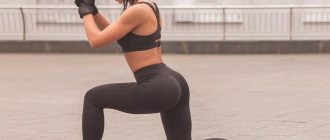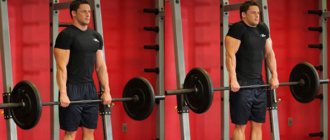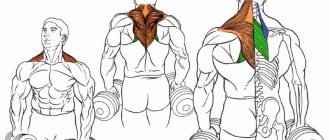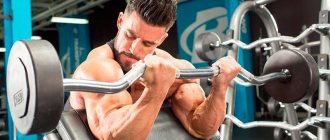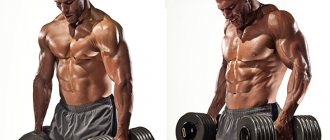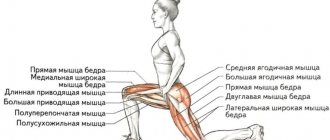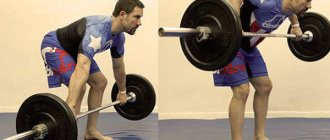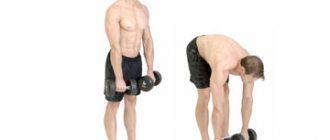Exercise Lunges with dumbbells or a barbell should be in every training program. But how to do the lunge exercise correctly?
Lunge exercise: 14 options for girls (photo)
11 Effective exercises for legs and buttocks for girls
Squats - correct technique (for girls)
There are many options for performing the exercise: lunges with dumbbells or with a barbell on the shoulders, in Smith, lunges back and forth, in place, lunges to the side (side lunges), Bulgarian lunges and even curtsy. Each option has its own characteristics and execution technique. I want to try to include all types of lunges in my training and it seems that there is probably the best type of lunge that will make your buttocks perfectly round and firm.
What are the best lunges for the buttocks? The best thing is variety. You don't need to change your workout program every week. But periodically replace the exercises with similar ones. For example, one month do forward lunges with a barbell, and the second month do backward lunges with dumbbells. Correct lunges for the buttocks are lunges with good technique.
Lunges: working muscles
To understand how to do proper lunges for the buttocks, you need to know which muscles will work.
Main muscles worked during lunges:
- leg muscles (quadriceps, hamstrings, adductors)
- buttock muscles (gluteus maximus, gluteus medius)
Accessory muscles:
- gastrocnemius
- press
- back straighteners
Lunges for the buttocks give them a round shape. And squats are needed to increase the volume of the buttocks. Which muscles work better in lunges? Of course, the buttocks. And in squats, most of the load is distributed between the muscles of the legs and back.
How to choose weight, number of approaches and repetitions
If you're doing weight training, do three to five sets of 8 to 12 reps on each leg. Select the weight in such a way that the last repetitions in the approach are difficult, but without any flaws in technique.
In other words, if by the 12th time the burning sensation in your hips increases, but you can still straighten your leg without lying with your stomach on your knee and without turning the joint inward, the weight is chosen correctly.
If you are training without weights, you can increase the number of repetitions to 20-25 times to achieve sufficient muscle stimulation. You can also add jumping - the explosive component will increase the load.
Lunges with dumbbells: how to do them correctly
Before we begin to describe the correct technique for performing lunge exercises, remember the main rule: the knee of the working leg never extends beyond the toe.
. It is not fatal if the knee extends just slightly beyond the toe. But just a little! In any type of Lunge exercise, tighten your abdominal muscles and “keep your chest forward” (squeeze your shoulder blades), even as you lean your body forward.
The most popular and safest equipment for lunges is dumbbells (lunges with a barbell are more difficult). Start doing lunges with the lightest dumbbells and gradually increase the number of repetitions and the weight of the dumbbells. For beginners this is the best option.
Lunges with dumbbells: how to do them correctly
Correct lunges with dumbbells: execution technique
- take dumbbells in your hands;
- take a step forward with one foot;
- lower yourself down so that your thigh is parallel to the floor and your knee does not go beyond your toe;
- the second leg remains behind, bent 90 degrees (with the knee not touching the floor);
- push off the floor with your front foot and return to the starting position;
- do the same for the second leg.
Lunges can be done either while standing still (as in the video) or with a step forward (as written above). When doing lunges with steps, you spend a little more energy (important for those who are losing weight), but the impact load on the knees is greater (important for those who have knee pain).
Number of repetitions
How to do lunges correctly? You can do lunges with dumbbells either alternately on one leg or the other (20 times in total), or first 10 repetitions for one leg, and then 10 for the other.
Injury hazard
No other exercise will help so effectively in shaping the relief of the legs. Some athletes prefer to perform this exercise without weights, but those who strive to achieve high results use it. To avoid injury, before performing the exercise, it is imperative to warm up thoroughly and then follow safety precautions. The first approach is recommended to be performed with your own weight (without weights). Failure to follow the instructions may result in serious injury or other adverse consequences.
Lunges with a barbell
Lunges with a barbell are more difficult than lunges with dumbbells. This is an option for “advanced” and not for beginners. You need to maintain balance and avoid “distortions”. When you do lunges with a barbell on your shoulders, you may “lead” to the left or right during the movement. Therefore, do not rush to increase the weight on the barbell, start with the lightest weight and learn to maintain balance. Lunges with a barbell also provide additional vertical stress on the back. Therefore, if you have a sore back (hernia, for example), then it is better to do lunges with dumbbells.
Correct lunges with a barbell: execution technique
- place the barbell on your shoulders;
- take a step forward with your right foot;
- lower yourself down so that your thigh is parallel to the floor and your knee does not go beyond your toe;
- the second leg remains behind, bent 90 (with the knee not touching the floor);
- take a step forward and lower yourself down;
- rise up without changing the position of your legs.
Number of repetitions
Just like when performing lunges with dumbbells, first do 10 lunges with a barbell on your right leg, and then 10 on your left.
Features and benefits of the exercise
Lunges with dumbbells are a complex exercise, the main load of which falls on the quadriceps, hamstrings, gluteus maximus, and calf muscles. For better coordination and maintaining balance, stabilizers are connected to them - the latissimus, rhomboids, trapezius back muscles, and abdominal muscles. When an exercise is performed with weights (dumbbells, a bar), the static load falls on the shoulders, forearms, and wrists.
Essentially, these are simply successive steps from each leg with a squat on the one that is currently in front. With a wide step, the maximum load is placed on the buttocks and hamstrings. With narrow and medium, it shifts to the quadriceps. Such lunges for girls are almost a mandatory exercise. Many of them come to gyms precisely for the sake of beautiful and elastic buttocks.
Lunges with dumbbells have the following undoubted advantages:
- minimum necessary equipment (you can work in the hall or at home);
- active burning of calories;
- improvement of coordination, general endurance;
- lower risk of injury than, for example, when doing squats with a barbell;
- greater efficiency compared to leg abduction or leg lifting in exercise machines;
- the opportunity to work on increasing the volume and compaction of muscle tissue or on relief (the exercise is also suitable for men);
- variety of variations.
The main advantage is the complex technique of performing the exercise despite its apparent simplicity. To learn to coordinate the movements and position of the upper and lower halves of the body, you have to spend a lot of time and effort. Therefore, you need to start practicing with an experienced instructor; a self-mastered technique exercise may turn out to be far from quality standards.
Mastering the correct technique is important. This is the only way the movement is anatomically natural and the likelihood of injury is reduced to almost zero. When making mistakes or working with clearly unbearable weights, joints and ligaments can be seriously damaged.
This exercise allows you to work several muscle groups at once.
The main advantage is the complex technique of execution despite the apparent simplicity
It is useful to include lunges with dumbbells in both women's and men's training; this is an effective exercise for fat burning and developing endurance.
Lunges with dumbbells/barbell while standing still
You can perform lunges not only with a step forward or backward, but also while standing still.
Correct lunges while standing still, execution technique:
- take dumbbells in your hands (or place a barbell on your shoulders);
- take a step forward and lower yourself down as for normal forward lunges;
- rise up without changing the position of your legs.
Whether you perform lunges with a barbell or with dumbbells depends on your health. See the table at the end of the article.
Number of repetitions
Do 10 repetitions on the right leg, and then 10 on the left. Only 3 approaches.
Difficulties and disadvantages of implementation
- The main difficulty is to “feel” the coordination of movement while performing the exercise without violating the technique. For beginners, it is better to start lunges without dumbbells. Then, as you feel the correctness of the movements, move on to working with weights, constantly increasing the weight.
- To hold heavy equipment in your hands, you will have to use straps or switch to a barbell.
- If you are a trained athlete with a lot of experience, then I recommend doing squats with a barbell as a base, and using lunges as a way to “build up” the muscles.
Back lunges (reverse lunges) and forward lunges
video lunges correct backward lunges (reverse lunges) and correct forward lunges
The classic version is forward lunges. You step forward with one leg, while the other remains behind. But you can also do backward lunges (reverse lunges). The difference is that instead of taking a step forward, you take a step back.
Back lunges are less damaging to your knees. Therefore, if you feel pain in your knee during forward lunges, then try backward lunges.
You can combine backward lunges (reverse lunges) and forward lunges - first step forward with one leg, then back with the same leg. This is 2 reps. A total of 10 such repetitions. Then change your working leg and do another 10 repetitions. This is 1 approach, you need 3 in total.
Contraindications and possible injuries
Exercises are traumatic for joints and muscles. Moreover, each option has its own risks. For example, the difference between forward and backward lunges is that when performing a forward lunge, the knee joint suffers more. And with cross lunges, most of the load is taken by the gluteal muscles, and you can pull the ligaments on the back of the thigh.
Bulgarian lunges can hurt your knees. Therefore, when practicing at home, do not overdo it. Contraindications to such training:
- high blood pressure;
- joint disease;
- existing injuries;
- varicose veins in the legs;
- pain in the knee area.
Basic mistakes when performing lunges with dumbbells:
- leaning the body forward can lead to injury to the lower back;
- placing the knee of the supporting leg on the floor leads to muscle relaxation;
- If the working leg's knee is not bent at 90° angles, this can lead to injury to the knee joint.
Bulgarian lunges with dumbbells
Tired of regular lunges? Try Bulgarian lunges with dumbbells.
Bulgarian lunges: execution technique
- take dumbbells in your hands;
- place the foot of your back leg on the bench (height - just below your knee);
- the other leg is in front, slightly bent at the knee;
- standing still, lower yourself down, bending your front leg until your thigh is parallel to the floor (knee does not go beyond your toe);
- if your knee extends beyond your toes, place your front foot a little further from the bench.
- repeat 10-12 times, change working leg and do another 10-12 times
- This is 1 approach, you need 3 in total.
When you do the Bulgarian lunges exercise for the first time, practice the technique without dumbbells. You need to learn how to perform lunges while maintaining your balance - you will “sway” to the sides. Don’t worry, the second or third time it’s easier to keep your balance and you’ll be able to do Bulgarian lunges with dumbbells in your hands correctly.
Number of repetitions
You can either do lunges on each leg in turn (16-20 times in total), or first on one leg 8-10 times, then on the second 8-10 times.
Injury prevention
To prevent injuries to ligaments and joints, follow these simple rules:
- Do not perform this exercise if you have had a recent injury or are feeling unwell;
- Don't forget about warming up. We do squats and lunges without weight, with feet and knees in place, bending forward;
- Hone your technique without load;
- When working with heavy weights, while taking a step, first place your back foot next to your front and only then step forward with it;
- If pain or discomfort occurs, stop performing squats immediately.
Side lunges (side lunges)
Side lunges engage the hip adductors (inner thighs) and gluteus medius (located above and below the gluteus maximus) more.
It is most convenient to do lunges to the side (side lunges) with dumbbells in your hands.
How to do lateral lunges correctly
- take dumbbells in your hands (the first time you can do it without dumbbells at all);
- take a step with one leg to the side and bend it at the knee, the other leg is straight (try not to lift your foot off the floor);
- the knee of the working leg is parallel to the foot, but does not extend forward beyond the foot;
- When moving down, tilt your torso slightly forward (as during squats);
- push the heel of your working leg off the floor and return to the starting position.;
- repeat 10-12 times, change the working leg and do another 10-12 times;
- This is 1 approach, you need 3 in total.
To do lateral lunges correctly, you need to do some warm-up and stretching beforehand. Your task is to take a step as wide as possible when lunging.
Number of repetitions
You can either do lunges on each leg in turn (20-24 times in total), or first on one leg 10-12 times, then on the other side 10 times.
Little secrets
Experienced athletes know many tricks that will make the same squats even more effective. Unfortunately, not everyone knows about this, but if, for example, you narrow the position of your legs, the load will increase significantly. And if you increase the angle of inclination of the body, the pressure on the legs will decrease, and on the back, on the contrary, it will increase. The deeper you squat, the greater the load on the buttocks, the more effective this exercise is. If you find it uncomfortable to hold your heels firmly against the floor, you can use a stand.
However, this time the effectiveness will be much less. More advanced bodybuilders perform these exercises not only with dumbbells, but also with a barbell, which is much more difficult and is not always possible for a beginner. But with enough persistence and desire to achieve high results, you can advance to a higher level of difficulty. The main thing is to remember that everything is done gradually and only persistent and regular training can achieve success. A harmonious combination of sports, proper nutrition, relaxation and work will make your life brighter, more successful and happier.
Originally posted 2018-01-09 08:55:00.
Curtsy lunges
This type of lunge, just like lunges with dumbbells to the side, better loads the gluteus medius (top of the buttocks) and adductor muscles (inner thigh).
How to do curtsey lunges correctly
To start, do these lunges without dumbbells, because... you need to learn to keep your balance.
- take a step with your left foot back and behind your right foot (as if you were doing a “curtsey”)
- the right (front) leg bends at the knee 90 degrees, the knee does not go beyond the toe
- push the heel of your right (front) foot off the floor and return to the starting position
Number of repetitions
As with other types of lunges, you can do 10-12 repetitions on one leg first, and then on the other. Or alternately - only 20-24 repetitions.
Training programs
Both men and girls often include lunges with dumbbells in their complexes.
Most popular programs:
| Women's Leg Day. Emphasis on the back of the thigh and glutes | |
| Exercise | Sets x reps |
| Romanian barbell deadlift | 4x12 |
| Lunges with dumbbells with an emphasis on the hamstrings | 4x10 (for each leg) |
| Smith squats with emphasis on the hamstrings and glutes | 4x12 |
| Seated leg curls | 3x15 |
| Standing single leg curls | 3x15 |
| Glute bridge with barbell | 4x12 |
| Women's Leg Day | |
| Exercise | Sets x reps |
| Barbell Squats at Smith | 4x15 |
| Lunges with dumbbells | 4x10 (each leg) |
| Leg press in the simulator | 3x12 |
| Plie squats with dumbbells | 3x12 |
| Glute bridge with barbell | 4x12 |
| Superset of leg extensions and flexions in exercise machines | 3x12+12 |
| Men's Leg Day | |
| Exercise | Sets x reps |
| Squats | 4х12,10,8,6 |
| Romanian deadlift | 4x10 |
| Leg press in the simulator | 3x12 |
| Walking lunges with dumbbells | 3x10 (each leg) |
| Leg extensions in the simulator | 3x15 |
| Leg curls in a lying machine | 3x15 |
Recipes for healthy eating
Uzbek pilaf on fire in a cauldron
- 7.9 g Protein
- 17.1 g Fat
- 24.9 g Carbohydrates
- 232 kcal
60-80 min.
- #mutton
- #barberry
- #second course
- #jeera
- #turmeric
- #carrot
- #dinner
- #paprika
- #chilli
- #pilaf
- #vegetable oil
- #onion
- #rice
- #dinner
- #garlic
Other recipes
What's the best way to do lunges?
As we wrote at the very beginning, variety is best. All girls do lunges for buttocks and slender legs. Perform different types of lunges to maximize the use of all the muscles in your legs and buttocks. Below is a cheat sheet for you.
| Types of lunges | Emphasis on muscles | Advantages/Limitations |
| Lunges with dumbbells | gluteus maximus, hamstrings, quadriceps | Less strain on the back than with a barbell, suitable for beginners |
| Lunges with a barbell | gluteus maximus, hamstrings, quadriceps | more load on the spine than with dumbbells |
| Back/Forward Lunges | gluteus maximus, hamstrings, quadriceps | we spend more energy than lunges in place; backward lunges put less strain on the knees than forward lunges |
| Lunges while standing still | gluteus maximus, hamstrings, quadriceps | Less stress on the knees, but we also burn fewer calories than with lunges with forward/backward steps |
| Lunges in Smith | gluteus maximus, hamstrings, quadriceps | less load on the spine than when lunging with a barbell; stabilizer muscles are not included in the work |
| Bulgarian lunges with dumbbells | gluteus maximus, hamstrings, quadriceps | the gluteal muscle is stretched more strongly (which means it works harder) |
| Side lunges (side lunges) | gluteus medius, adductors (inner thighs)gluteus medius, adductors (inner thighs) | The gluteus medius is better engaged (good for the upper buttocks) and the inner thighs The gluteus medius is better engaged (good for the upper buttocks) and the inner thighs |
| Curtsy lunges |
If you liked the article, share with your friends!
.
What alternatives are there to this exercise?
Lunges with dumbbells are an effective exercise for the buttocks and thighs, and should not be ignored unless there is a compelling reason to do so. If axial load on the spine is contraindicated for you, try performing lunges in a hack machine or Smith machine. This way you will not only protect your spine, but also work on your target muscle groups in more isolation.
You can perform steps onto a box or other hill ; the biomechanics of this movement and classic forward lunges are almost the same, and in terms of the effectiveness of steps, they are in no way inferior to lunges. Watch the position of your body and perform this exercise with a straight back, without leaning forward.
Pistol
Single-leg pistol squats can also replace cross lunges, but performing this exercise in a high rep range will be harder for most athletes since single-leg squats require more control and balance.
Sissy squats
Sissy squats are a technically difficult and traumatic, but at the same time incredibly effective exercise. We hold onto some support with our hands, direct our pelvis and knees forward, and ourselves lean back as far as possible. We perform the movement until the biceps of the thigh lies on the calf muscle, and the knees are extended as far as possible beyond the level of the toes. The unusual thing about this exercise is that here we rely not on the heel or the entire foot, but on the toe. Huge range of motion, isolated and targeted work of the quadriceps. If you don't want to do forward lunges or cross lunges, try doing sissy squats at the end of your leg workout, when all the ligaments and muscles are fairly tired. It’s hard, painful, difficult, but effective.
Jumping on a box
Box jumps or spring jumps are less effective for the glutes and thighs than classic lunges, but can be a great complement to forward lunges or cross lunges. Try doing several sets of lunges and jumping jacks in a row without stopping for a great, functional cardio workout.
For beginners, it is best to perform the exercise without additional weights. This way you will be able to perform lunges more technically, since you will not collapse under the weight of a dumbbell or barbell.
Exercises for girls
Lunges with weights are very beneficial for your figure. With their help, you can form correct posture and make your waist beautiful. In addition, the body becomes more flexible and graceful. But that is not all. Many trainers recommend lunges with dumbbells for girls because they are better than other exercises for bringing the buttocks back to normal.
During training, the fair sex should use weights that are not too heavy. Five-kilogram shells will be enough. This will reduce the load on the spine. And to increase the effectiveness of training, broader steps should be taken. This approach will make the exercises more effective and reduce the likelihood of injury.
